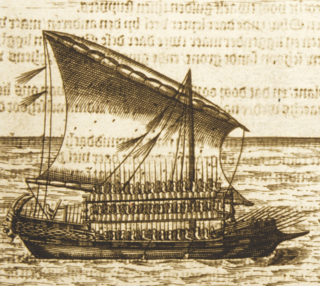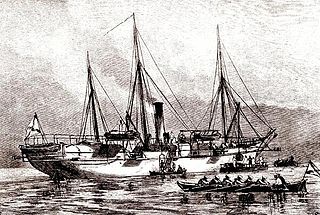 W
WA warship or combatant ship is a naval ship that is built and primarily intended for naval warfare. Usually they belong to the armed forces of a state. As well as being armed, warships are designed to withstand damage and are usually faster and more manoeuvrable than merchant ships. Unlike a merchant ship, which carries cargo, a warship typically carries only weapons, ammunition and supplies for its crew. Warships usually belong to a navy, though they have also been operated by individuals, cooperatives and corporations.
 W
WThe central battery ship, also known as a centre battery ship in the United Kingdom and as a casemate ship in European continental navies, was a development of the (high-freeboard) broadside ironclad of the 1860s, given a substantial boost due to the inspiration gained from the Battle of Hampton Roads, the first battle between ironclads fought in 1862 during the American Civil War. One of the participants was the Confederate casemate ironclad CSS Virginia, essentially a central battery ship herself, albeit a low-freeboard one. The central battery ships had their main guns concentrated in the middle of the ship in an armoured citadel. The concentration of armament amidships meant the ship could be shorter and handier than a broadside type like previous warships. In this manner the design could maximize the thickness of armour in a limited area while still carrying a significant broadside. These ships meant the end of the armoured frigates with their full-length gun decks.
 W
WCommand ships serve as the flagships of the commander of a fleet. They provide communications, office space, and accommodations for a fleet commander and his staff, and serve to coordinate fleet activities.
 W
WThe djong, jong, or jung is a type of ancient sailing ship originating from Java that was widely used by Javanese and Malay sailors. The word was and is spelled jong in its languages of origin, the "djong" spelling being the colonial Dutch romanisation.
 W
WGhali, gali or gale are a type of galley-like ships from the Nusantara archipelago. Several native galley-like ships already existed in the archipelago, some with outriggers. The design of ghalis is the result of the impact made by Mediterranean shipbuilding techniques on native shipbuilding, introduced particularly by Arabs, Persians, Ottoman Turks, and Portuguese. The terms may also refer to Mediterranean vessels built by local people, or native vessels with Mediterranean influence.
 W
WGhurab or gurab is a type of merchant and warship from Nusantara archipelago. The ship was a result of Mediterranean influences in the region, particularly introduced by the Arabs, Persians, and Ottoman.
 W
WA juanga or joanga refers to large-sized kora-kora or karakoa. They are used in Southern Philippines and Eastern Indonesia, in Maluku smaller versions existed. They are propelled by oars but are not used for carrying cargo.
 W
WKnabat bogolu is a type of traditional war vessel from Mentawai islands, west Sumatra, Indonesia. This vessel is shaped like a kora kora, but with different outrigger boom placement. Like kora kora, it also has deckhouse at the center of the hull. It has two main booms which slope down to the float and each has an accessory boom. A boom-spar is located above the vessel, one end of which rests on the roof. The float (katir) is double on each side. It has 2 masts, each rigged with narrow, very high sails from bamboo and palm leaf. The stern of the vessel is more highly arched than the bow. Both the bow and the stern had decorative tufts and ropes. The roofing is solid through the entire length, about 30-40 ft long. At the bottom of this shelter weapons and food are stored in the hold of the vessel. When going to war it will be stocked full of provisions. On such a journey from which the women are excluded, all fighters are adorned in full armor. The number of crew they carry could be up to 100 men.
 W
WA kora-kora or kora kora or coracora is a traditional canoe from the Maluku (Moluccas) Islands, Indonesia. They are naval boat for carrying men on raids for plunder or for slaves. In Nusantara archipelago, raiding for slaves was an honourable way of making a living, and the kora kora was needed for defence against raids as well as for forays. Large kora-kora is called juanga or joanga.
 W
WKotta mara is a type of floating battery or fortified raft from Borneo. It is used by native Bornean in warfare, its usage rose prominently during the Banjarmasin war (1859-1906). Kotta mara is used in riverine warfare, as an armed vessel or simply a blockhouse or fortification to prevent enemy advance in the river.
 W
WLancang is a type of sailing ship from Maritime Southeast Asia. It is used as warship, lighter, and as royal ship, particularly used by the people of Sumatran east coast, but can also be found in the coast of Kalimantan.
 W
WA Lancaran is a type of sailing ship used in the Nusantara archipelago. Although similar in shape to Mediterranean galleys, lancaran was the backbone of the regional fleet before Mediterranean influence came.
 W
WThe man-of-war was a Royal Navy expression for a powerful warship or frigate from the 16th to the 19th century. Although the term never acquired a specific meaning, it was usually reserved for a ship armed with cannon and propelled primarily by sails, as opposed to a galley which is propelled primarily by oars.
 W
WA patache is a type of sailing vessel with two masts, very light and shallow, a sort of cross between a brig and a schooner, which originally was a warship, being intended for surveillance and inspection of the coasts and ports. It was used as a tender to the fleet of vessels of more importance or size, and also for trans-Pacific travel, but later began to be used for trading voyages, carrying cargo burdens of 30 tons or more.
 W
WThe torpedo boat tender was a type of warship developed at the end of the 19th century to help bring small torpedo boats to the high seas, and launch them for attack.
 W
WA zabra (zah-brə) was a small or midsized sailing vessel used off the coasts of Spain and Portugal to carry goods by sea from the 13th century until the mid-16th century; they were well-armed to defend themselves against pirates and corsairs. Early Iberian documentary sources, such as the Estoria de España, refer to their use by the Moors (Moros). From about 1500 onwards a fleet of zabras developed in the coastal trade of Cantabria on the Cantabrian Sea, and fishermen began using them to exploit the fisheries of Ireland and North America. These zabras were fast, square-rigged row-sailers with two masts; they were rowed with 14 to 18 oars and had a tonnage of between 20 and 60 tons. Their ratio of beam to length was 1: 3.75–4.0. The smallest zabras had only a half deck or a poop deck, but the larger ones were covered with a flush deck. Because of their excellent handling qualities, and despite their modest size, they were frequently used by the Crown of Castile for the transport of money and soldiers to Flanders, as well as in transatlantic voyages.